|
Microfilm-covered indoor models
is one (of many) aspects of model airplane building and flying that I've always
wanted to try, but never found the opportunity. You might be tempted to think this
is the exclusive realm of white-haired old men, and admittedly it nearly is, but
when you look at contest coverage in the modeling magazines, it is heartening to
see a good showing of youngsters. For that matter, the same holds true for just
about all forms of model aircraft these days except for radio controlled airplanes
and helicopters. As recently as a couple decades ago, radio equipment was too expensive
for many younger modelers to buy, so those who aspired to hobbies involving airborne
craft had to settle for free flight and control line. Now, the department store
shelves hold no control line or free flight models, but a nice selection of miniature
R/C helis and airplanes. But I digress. This 1954 Model Airplanes News
magazine article by John Zaic is a very comprehensive
set of instructions on how to cover airframes with microfilm (a
pyroxylin mixture), enhanced by many photos
of the actual process. It would be nice to see an complementary building article,
and maybe there was, but if so I don't have that issue. Maybe someday.
Facts About Microfilm Covering
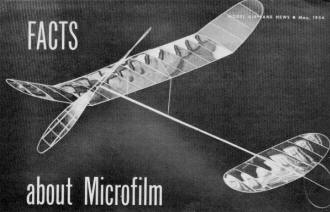
Light reflected in colors from microfilm indicates thickness:
clear and green too heavy, red-green, red-gold, red-violet progressively thinner.
Ninety-nine out of one hundred modelers do not know how to make microfilm. Nine
out of ten never heard of it. Now we have no excuse to avoid a slow-motion model!
by John Zaic
The wonder indoor model covering material, rainbow colored and gossamer thin
- microfilm - was discovered and introduced to us by Bob Clary and his friend, Jerome
Kittel, around 1930. It was the most important contribution ever made to indoor
model construction and it has made present records possible.
Microfilm is so thin that light reflected from its surface is colored just like
that reflected from oil rings in the water. The thickness is believed to be one
ten-thousandths of an inch. Its weight is approximately .003 oz. per 100 sq. in.
The film is made of a pyroxlin mixture that is poured on water. A plastic sheet
is formed on the surface and is picked up with a wire hoop. The model structure
is then covered with the film.
If practice facilities were available, Pete Andrews, the present world indoor
record holder of 32 minutes-plus, believes the record today would be near 40 minutes!
And now for a bit of fantasy in regard to a 60 minute indoor model. There is
a rumor that air foam plastics have been made so light that they float in air. The
foaming agents give off hydrogen gas which is trapped in thousands of plastic cells.
The gas probably diffuses in time.
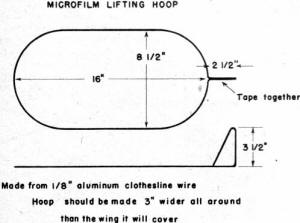
Made from 1/8" aluminum close line wire. Hoop should be 3" wider
all around that the wing it will cover.
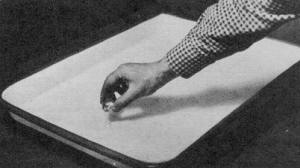
Use bottle cap to pour solution on water. Start at one end, rapidly
pour solution down middle t other. Less solution for thinner film.
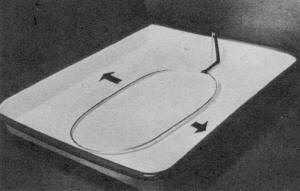
Holding handle, place hoop on film. Slide hoop to one side first,
then the others. This action accordions excess film and packs it against hoop.
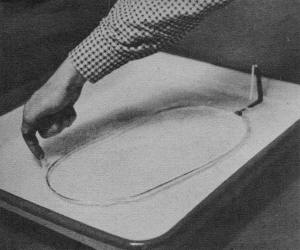
Using wet finger, push the rest of the surplus film against wire,
then over wire in order to hold it to hoop for lifting.
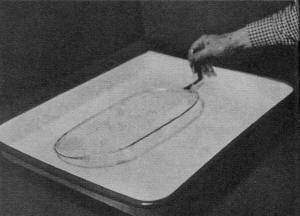
To pick up film from water, carefully move hoop to one side of
tray, slowly tilt up one side, ten slide forward and lift hoop up and over.
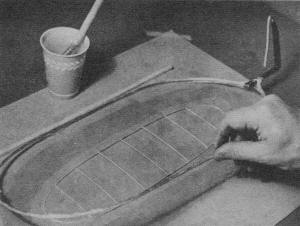
Wings, stabs: cement strip wood to suitable surface. Place adhesive
on frame. Wet bench (dark circle). Press hoop against strip, lay down on frame.
Press film to frame with dry finger, but do not press to ribs.
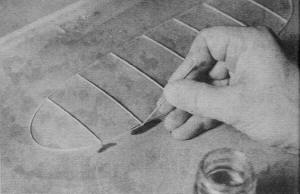
For extra light frameworks, adhesive sometimes applied after
film put on. Aluminum tube, about 1/32 in. inside diameter, dipped in adhesive,
placed back edge wing spar, piercing fil. Liquid flows along spar.
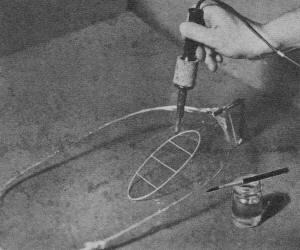
Simple frameworks moistened with adhesive, laid on microfilm,
removed from hoop by hot iron or small brush moistened with thinner, acetone.
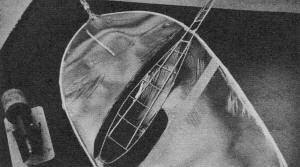
Apply saliva with a brush if necessary. Roll prop again, press
film in place at center, trailing edge, cut out. Thus, all way around the prop.
Another interesting thought is an old one. Remember how you laugh when someone
suggests that you fill the wings and fuselage with gas, like a Zeppelin, to make
the model lighter so it will fly better? Brother, if you are an indoor builder,
don't laugh too quickly. Microfilm is quite dense as a membrane. Compare the weights
of a rubber balloon and an indoor model. Note the weight of hydrogen in comparison
with air. Remember, indoor contest rules permit 300 sq. in. of wing area.
The author made a 6-in. cube with edges of 1/32 in. square balsa and covered
it with microfilm. The air inside was displaced with hydrogen. The cube, when released,
hit the ceiling. In other words, a double surfaced indoor wing with the air inside
displaced with hydrogen may lift its own weight, but the other components would
make the model a heavier-than-air craft. The total weight would be less than that
of a standard model. Gas diffusion would be the main problem. I think it is an interesting
idea.
It is not easy to buy a prepared microfilm solution. Jasco has a special contest
solution, used by Pete Andrews, that sells for $2.50 a Pint. Preparing a microfilm
formula is a tricky affair and there are hundreds of formulas. An excellent beginner's
mixture consists of the following:
To 1 oz. of DuPont Duco Lacquer 1907 (Clear), add eight drops of castor oil.
Mix well and allow to settle a while before using. The lacquer is bought from dealers
who stock duPont automobile lacquers. You may try using more or less oil, or no
oil at all, until you get a type of film that you like. Olive oil may also be used.
The experts use Tri Cresyl Phosphate and that may be ordered through the drugstore.
Film made without oil may split easily and is difficult to pick up from the water.
Oil will make the film slightly elastic, so that if it is touched accidentally it
will bend in a bit instead of splitting instantly. At most a small. hole will be
made that can be patched. Tri Cresyl Phosphate is preferred to castor oil because
it will make a film flexible with almost no tackiness that collects dust. It is
better to use too little oil than too much.
The consistency of the lacquer is very important. A too thin mixture, when poured
on the water, will spread star-fashion in all directions and will not form a sheet.
A too heavy mixture will spread out only a short distance and then stop. Evaporation
will thicken the mixture and the manufacturer's thinner applied to reduce it.
The thickness of the microfilm is determined by the color of light it reflects.
Transparent clear and green are seldom used, being roo heavy. Red green, red gold
and red violet are the popular sheets used, with thickness diminishing rapidly.
Dark violet is about the thinnest that can be used and is used for ROG's or small
areas. Silver is so thin that I don't believe it has been picked up from the water.
By using less solution for a given water tank, the sheets will become thinner.
A bathtub is ideal for making microfilm Any container that can hold about a 1/2-in.
of water and is about 4 in. larger all around than the wire hoop used is satisfactory.
Oilcloth placed over a simple wooden frame and filled with water will do. The temperature
of the water should be about 65°.
Aluminum clothesline wire, about 1/8 in. diameter, is excellent for the hoops.
I use a kitchen pot to bend it round and all-rubber electrician's tape to hold the
handle part together. Take considerable pains to make the hoop flat.
Saliva is used as an adhesive to stick microfilm to framework. Rubber cement
diluted about 10 times with benzine has been used. I use Esso spot remover plus
some varnish and find it works very well, especially on ultra light construction.
The Esso spot remover can be purchased at some gasoline dealers. Any adhesive, except
saliva, should be first tested to see that it does not dissolve the microfilm.
How to make and cover with "mike" is shown in the accompanying sequence of pictures.
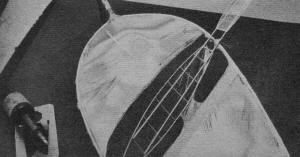
Hub not covered. Hub rests on wire hoop throughout. Paper strip,
saliva cemented across film, conserves material. Take out wrinkles with heat.
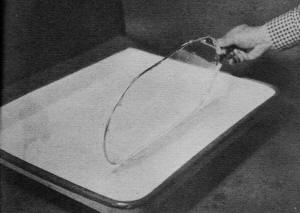
Position of hoop as it is finally lifted without breaking film.
If you can lift red-violet film without breakage, you're an expert, says author.
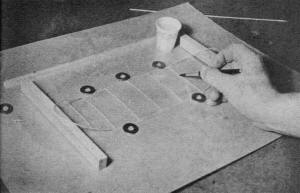
Dihedral: Adhesive on dihedral rib. Nick edges, lift tips, blocks
for angle, cement joints. If wrinkles, draw wet brush along dihedral rib.
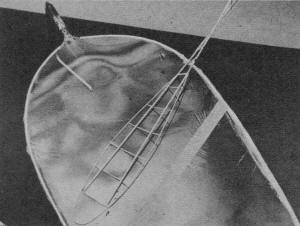
Prop: Apply saliva to ribs, outline. Place leading edge on film,
be sure it adheres. Cut out with hot soldering iron, or acetone soaked brush.
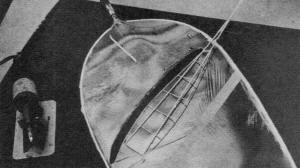
Roll prop on film, make sure trailing edge near tip adhered to
film. Press film to frame with finger if necessary, cut out again with hot iron.
Posted January 11, 2023
(updated from original post on 3/1/2014)
|


